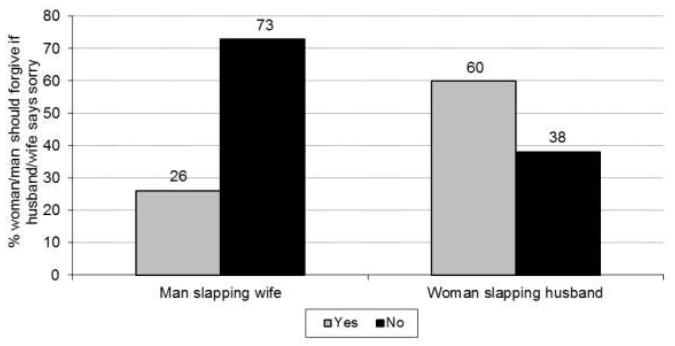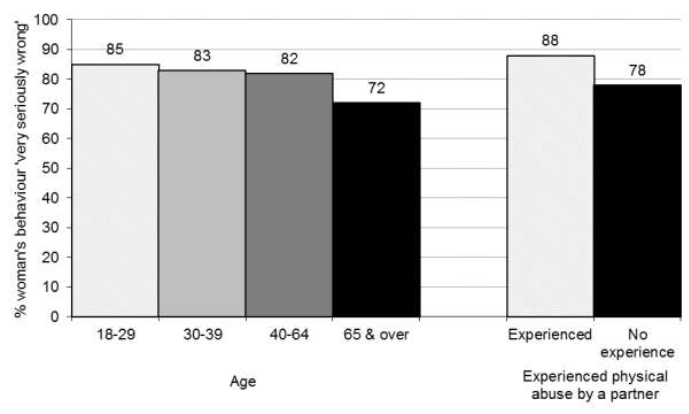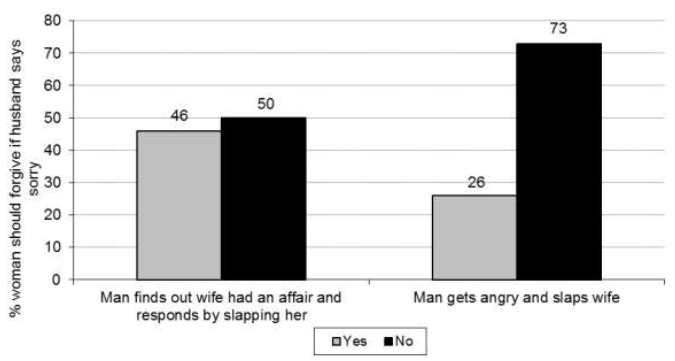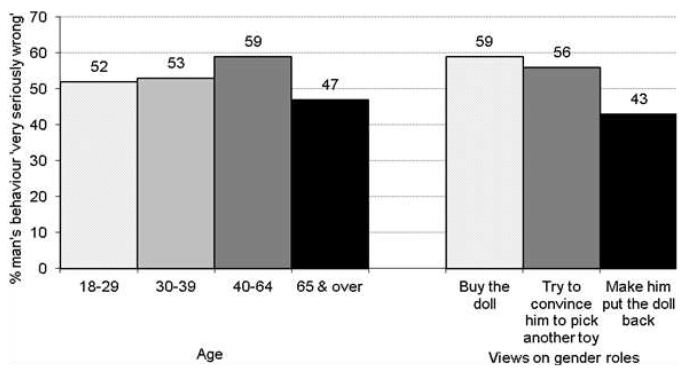Scottish Social Attitudes Survey 2014: Attitudes to violence against women in Scotland
This report presents findings from the 2014 Scottish Social Attitudes survey on the attitudes of the Scottish public to the following forms of violence against women: sexual violence, domestic abuse (physical, verbal, mental and emotional), sexual harassment and commercial sexual exploitation.
This document is part of a collection
3. Attitudes to domestic abuse: Physical abuse
This chapter and the following chapter examine people’s attitudes to domestic abuse. This chapter covers attitudes to physical abuse, while the following one (Chapter 4) looks at attitudes to verbal abuse and coercive-controlling behaviours. There is no single, universally accepted definition of domestic abuse. However, the definition developed by the Scottish Partnership on Domestic Abuse (2000) was:
‘Domestic abuse can be perpetrated by partners or ex partners and can include physical abuse (assault and physical attack involving a range of behaviour), sexual abuse (acts which degrade and humiliate women and are perpetrated against their will, including rape) and mental and emotional abuse (such as threats, verbal abuse, racial abuse, witholding money and other types of controlling behaviour such as isolation from family and friends).
The Scottish Crime and Justice Survey (SCJS) 2012-13 (Scottish Government, 2014b) showed that 3% of adults in Scotland had experienced either psychological or physical abuse by a partner within the last 12 months, while as many as 14% reported experiencing such partner abuse (psychological or physical) at some time since they were 16. Women were more likely than men to report partner abuse since the age of 16 (defined as having experienced at least one incident of psychological or physical abuse by a partner): 17% of women compared with 10% of men. Women are also more likely to have experienced recurring, and more serious, assaults, experienced ill health and be less financially independent than men who experienced abuse ( et al, 2013).
In relation to the impact of abuse, women were more likely than men to report multiple psychological effects compared with men: 20% of women reported four or more psychological effects compared with only 5% of men. And women were more likely than men to report a range of different psychological effects of abuse, including experiencing psychological or emotional problems, loss of trust and experiencing fear, anxiety and panic attacks. For example, 26% of women reported a loss of trust in others and difficulties in other relationships compared with 12% of men (Scottish Government, 2014b).
Domestic abuse occurs between partners, irrespective of the legal status of their relationship, or whether they live together. However, for the purposes of this survey, reference was made in the scenarios on domestic abuse to just one type of relationship – a married couple. This was intended as a proxy for people in a relationship. This particular relationship was chosen because it is a status that is known and understood throughout the general population. Also, by using one type of relationship across all the scenarios, we avoid the possibility that any differences in attitudes are due to people’s attitudes to different types of relationships rather than their views about the different behaviours.
Respondents’ views were sought both when the woman was the victim or when the man was the victim. Half of respondents were asked their views when the woman was the victim and half when the man was the victim. Comparing these two sets of attitudes enables us to establish whether people adopt a consistent attitude towards a particular form of abuse, or whether in fact their views were dependent on the gender of the victim.
SSA 2014 asked respondents about their attitudes to different types of physical domestic abuse by describing three different scenarios.
- a man getting angry and slapping his wife
- a woman getting angry and slapping her husband
- a man finding out his wife had an affair and slapping her
The reason for including different scenarios was to explore whether people’s attitudes depend on the gender of the perpetrator and the victim together with the circumstances in which the physical abuse took place. The first of these scenarios was designed to act as a ‘baseline’ measure of people's attitudes towards physical abuse, i.e. it described a behaviour that we anticipated a high proportion of people in Scotland would think was wrong and could therefore serve as a baseline against which to compare many of the other questions in the module.
Half of the respondents were asked about the first scenario, in which the physical abuse was perpetrated by a man (on his wife); and the other half were asked the second scenario, which was exactly the same except that the physical abuse was perpetrated by a woman (on her husband). All respondents were asked the third scenario about a man finding out his wife had an affair and slapping her. For each scenario, people were asked what they thought of the man’s (or woman’s) behaviour on the 7-point ‘wrong’ scale from 1 ‘not wrong at all’ to 7 ‘very seriously wrong’ and also what level of harm they thought it did to the woman (or man). In more detail, the scenarios were as follows:
(Scenario 1 & 2): Thinking about the same couple where the man/woman sometimes puts down his wife/her husband and criticises her/him[4]. Imagine that one day he/she also gets angry and ends up slapping her/him in the face.
(Scenario 3): Imagine a married couple that have been together for a while. One evening the man's wife tells him that she has been having an affair. He has never hit her before, but he responds to this news by slapping her in the face.
Attitudes to a man/woman getting angry and slapping his wife/her husband
Table 3.1 shows that the ‘baseline’ scenario did indeed elicit a high proportion of people who thought that the man’s behaviour was ‘very seriously wrong’: no less than 92% did so. Meanwhile, almost everyone (98%) placed it at point 5 or above, therefore situating it at the ‘seriously wrong’ end of the scale.
Table 3.1 Attitudes towards the perpetrator’s behaviour – getting angry and slapping wife/husband
| Man slapping his wife | Woman slapping her husband | |
|---|---|---|
| 7 Very seriously wrong | 92% | 81% |
| 6 | 5% | 11% |
| 5 | 1% | 3% |
| 4 | 1% | 2% |
| 3 | - | 1% |
| 2 | * | * |
| 1 Not wrong at all | 1% | 1% |
| Don’t know/Refusal | 2% | * |
| Weighted bases | 738¥ | 695^ |
| Unweighted bases | 740¥ | 688^ |
Base: All respondents who completed either Version A¥ or Version B^ of the self-completion
However, although most people also thought the behaviour of the woman who slapped her husband was wrong – 95% chose point 5 or above – rather fewer (81%) said that it was ‘very seriously wrong’.
A similar pattern was found when respondents were asked what harm, if any, the violence did to the victim. On the one hand, almost as many people (95%) thought the behaviour would do either ‘a great deal’ or ‘quite a lot’ of harm, when the man was the victim, as did so when the woman was (97%). On the other hand, no less than 89% thought the man getting angry and slapping his wife caused ‘a great deal’ of harm to the woman, whereas only 62% thought the woman slapping her husband did ‘a great deal’ of harm (see Annex A, Table A3.3 and A3.4).
Should the woman/man forgive their husband/wife if he/she says they are sorry?
In the case of these two scenarios, respondents were also asked whether the woman/man should forgive her husband/his wife if he/she immediately said how sorry they were for slapping her/him. The possible responses were: yes, definitely; yes, probably; no, probably not; and, no, definitely not.
Only a quarter (26%) thought that the woman who had been slapped should ‘definitely’ or ‘probably’ forgive her husband if he told her how sorry he was for slapping her (see Figure 3.1 ). Nearly three-quarters (63%) took the opposite view. However, the balance of opinion was very different when the genders were reversed. No less than 60% thought that the man should ‘definitely’ or ‘probably’ forgive his wife, while just 38% did not. So, although initially people were only a little less negative about the wife’s behaviour than that of the husband’s, they were much more inclined to think that it can be forgiven.
Figure 3.1 Whether the woman/man should or should not forgive their husband/wife

Base: All respondents who completed either Version A or Version B of the self-completion
Unweighted bases: Man slapping wife=740; woman slapping husband=688
See Annex A, Tables 3.7 and 3.8 for weighted bases.
How do attitudes to slapping vary between groups?
This section explores whether attitudes to a man or a woman getting angry and slapping his wife/her husband varied by:
- Gender
- Age
- Income
- Education
- Whether someone had ever experienced physical abuse by a partner
- Whether they hold stereotypical views about gender roles
There were no significant differences between any of these groups in the proportion who felt the man’s behaviour was very seriously wrong (see Annex A, Table A3.1). This is not surprising given the high proportion of people who gave this response.
However, people’s attitudes towards a woman slapping her husband did vary. Figure 3.2 shows that older people (aged 65 and over) were less likely than people in any of the other age categories to think that the woman’s behaviour was very seriously wrong; only 72% of those aged 65 and over did so compared with 85% of those aged 18-29.
Figure 3.2 also shows that there was a significant difference between the views of those who had experienced physical abuse by a partner and those who had not. As many as 88% of those who reported having experienced physical abuse by a partner thought the woman’s behaviour was ‘very seriously wrong’, compared with 78% of those who had not. In addition, those with higher levels of formal qualifications (Highers or degrees) (84%) were more likely than those with Standard grades or no formal qualifications (74%) to say that the woman’s behaviour was very seriously wrong.
Holding stereotypical views about gender roles was also significantly associated with attitudes to the woman’s behaviour. Those who held stereotypical views about gender roles (72%) (that is, they would have made the boy put the doll back) were less likely to think that the woman’s behaviour was ‘very seriously wrong’ than those who did not (that is, they would have bought the doll without saying anything) (89%).
Figure 3.2 How attitudes vary towards a woman slapping her husband

Base: All respondents who completed the self-completion
Unweighted bases: Age: 18-29=85; 30-39=99; 40-46=314; 65 & over=189.
Experience of physical abuse by a partner: Experienced=78; No experience=487.
See Annex A, Table 3.2 for weighted bases.
Many of the same differences were evident in people’s views about the level of harm caused to the husband by his wife slapping him. Older people (aged 65 and over) were less likely than people in any of the younger age groups to think that the behaviour would cause the man ‘a great deal’ of harm. And those with previous experience of physical abuse by a partner were more likely than those without to take that view: 70% compared with 59% respectively (see Annex A, Table A3.2).
Those with no formal qualifications (52%) were less likely than those with formal qualifications (Standard grades, Highers or degrees) (63%) to say that the woman’s behaviour would cause the man ‘a great deal’ of harm. Equally, those who held stereotypical views about gender roles (56%) were less likely than those who did not (69%) to think that the woman’s behaviour would cause ‘a great deal’ of harm.
However, in this case, gender also made a significant difference. Women (67%) were more likely than men (57%) to think that the wife slapping her husband would result in ‘a great deal’ of harm.
Although we found that there were no significant differences in people’s views about whether the man was ‘very seriously wrong’ in slapping his wife, there was one significant, if small, difference when it came to whether the violence caused the woman harm: 90% of those who did not hold stereotypical views about gender roles felt that the behaviour did ‘a great deal’ of harm, compared with 85% of those who did.
How do attitudes to whether the woman/man should forgive her/his partner vary between groups?
Irrespective of the gender of the perpetrator and the victim, both older people and those who held stereotypical views about gender roles were more likely to say that the perpetrator should be forgiven if they immediately said that they were sorry (see Annex A, Tables A3.9 and A3.10). For example, 40% of those aged 65 and over felt that the woman should forgive the man, compared with just 21% of those aged 18-29. Similarly, with regards to views on the man forgiving his wife, 69% of those with stereotypical views about gender roles thought he should forgive his wife compared with 49% of those who did not hold stereotypical views.
In the case of whether the man should forgive his wife, gender and past experience of physical abuse by a partner also made a difference. Surprisingly perhaps, men (69%) were more likely than women (50%) to think that the man should forgive his wife. Meanwhile, 69% of those who had never experienced any form of gender-based violence thought the man should be forgiven, compared with 49% of those who had experienced physical abuse by a partner.
Attitudes to a man slapping his wife after she has had an affair
This section discusses the last of the three scenarios that were outlined earlier: people’s attitudes towards a man slapping his wife in the face after finding out that she has had an affair. Note that, as well as advising respondents that the violence occurred immediately after the husband has found out about the affair, this scenario also indicated that this was the first time he had ever hit his wife. Either or both of these pieces of information may have made a difference to people’s views – and those views were clearly different. As Table 3.2 shows, just over half (54%) thought that the man's behaviour was ‘very seriously wrong’, well below the 92% who expressed that view in response to the first scenario, in which the man is simply described as getting angry.
Table 3.2 How wrong is the man's behaviour if he slaps his wife after finding out she had an affair
| 7 Very seriously wrong | 54% |
| 6 | 18% |
| 5 | 10% |
| 4 | 9% |
| 3 | 4% |
| 2 | 1% |
| 1 Not wrong at all | 1% |
| Don’t know/Refusal | 2% |
| Weighted bases | 1433 |
| Unweighted bases | 1428 |
Base: All respondents who completed the self-completion
This difference in attitudes if the wife has had an affair also extends to people’s perceptions of the harm that the man’s behaviour does to his wife. Less than half (48%) felt that the man’s behaviour caused ‘a great deal’ of harm to his wife after she had an affair, well down on the 89% who gave that response to the first scenario (see Annex A, Table A3.12).
Equally, as Figure 3.3 shows, almost as many felt that in these circumstances the woman should forgive her husband (46%) as thought that she should not forgive him (50%). This stands in sharp contrast to the 26% who said that the wife should forgive her husband when he had slapped her after getting angry – perhaps because some people felt that the affair placed some obligation on the wife to forgive this unprecedented violence. Further research would be needed to examine whether people would always be inclined to be more forgiving of a one-off incidence of violence, regardless of the other circumstances, and whether the revelation of an affair would make as much difference to people’s views if this was not the first time that the man had slapped his wife.
Figure 3.3 Whether the woman should or should not forgive her husband

Base: Man finds out wife had an affair and responds by slapping=1428. Man gets angry and slaps wife=740.
See Annex A, Tables 3.10 and 3.14 for weighted bases
How do attitudes to a man slapping his wife after she has had an affair vary between groups?
In what are by now familiar and largely consistent patterns, older people and those with stereotypical views on gender roles were less likely to think that the man slapping his wife after she has had an affair was wrong and caused harm to his wife, while at the same time they were also more likely to think that the wife should forgive her husband.
As Figure 3.4 shows, those aged 65 and over were less likely than those in any other age group to say that the man’s behaviour was ‘very seriously wrong’. Equally, only 47% of those aged 65 and over said that the slap would do ‘a great deal’ of harm to the wife, compared with 52% of those in the youngest age group. And while 60% of older people said that the woman should forgive the man, only 45% of those aged 18-29 did so.
Figure 3.4 also shows how those with stereotypical views about gender roles were markedly less likely to say that the man’s behaviour was ‘very seriously wrong’. Only 39% of this group said that the behaviour would do ‘a great deal’ of harm, compared with 57% of those who did not hold stereotypical views. Meanwhile, 55% of those who held stereotypical views about gender roles thought that the woman should forgive the man, compared with just 38% of those without. In relation to the harm done by the man’s behaviour, education was also related to people’s views. Those with no formal qualifications (40%) were less likely than those with formal qualifications (Standard grades, Highers or degrees) (50%) to say that the man’s behaviour would cause ‘a great deal’ of harm to the woman.
Figure 3.4 Believing the man’s behaviour is ‘very seriously wrong’ if he slaps his wife after finding out she had an affair by age and holding stereotypical views on gender roles

Base: All respondents who completed the self-completion
Unweighted bases: Age: 18-29=179; 30-39=212; 40-46=646; 65 & over=390.
Views on gender roles: Buy the doll=567; Try to convince him to pick another toy=495; Make him put the doll back=351.
See Annex A, Table 3.11 for weighted bases.
Contact
Email: Alison Stout
There is a problem
Thanks for your feedback